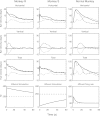Spatial and temporal properties of eye movements produced by electrical stimulation of semicircular canal afferents
- PMID: 22673321
- PMCID: PMC3544955
- DOI: 10.1152/jn.01029.2011
Spatial and temporal properties of eye movements produced by electrical stimulation of semicircular canal afferents
Abstract
To investigate the characteristics of eye movements produced by electrical stimulation of semicircular canal afferents, we studied the spatial and temporal features of eye movements elicited by short-term lateral canal stimulation in two squirrel monkeys with plugged lateral canals, with the head upright or statically tilted in the roll plane. The electrically induced vestibuloocular reflex (eVOR) evoked with the head upright decayed more quickly than the stimulation signal provided by the electrode, demonstrating an absence of the classic velocity storage effect that improves the dynamics of the low-frequency VOR. When stimulation was provided with the head tilted in roll, however, the eVOR decayed more rapidly than when the head was upright, and a cross-coupled vertical response developed that shifted the eye's rotational axis toward alignment with gravity. These results demonstrate that rotational information provided by electrical stimulation of canal afferents interacts with otolith inputs (or other graviceptive cues) in a qualitatively normal manner, a process that is thought to be mediated by the velocity storage network. The observed interaction between the eVOR and graviceptive cues is of critical importance for the development of a functionally useful vestibular prosthesis. Furthermore, the presence of gravity-dependent effects (dumping, spatial orientation) despite an absence of low-frequency augmentation of the eVOR has not been previously described in any experimental preparation.
Figures





Similar articles
-
Vestibuloocular reflex adaptation investigated with chronic motion-modulated electrical stimulation of semicircular canal afferents.J Neurophysiol. 2010 Feb;103(2):1066-79. doi: 10.1152/jn.00241.2009. Epub 2009 Dec 16. J Neurophysiol. 2010. PMID: 20018838 Free PMC article.
-
Semicircular canal contributions to the three-dimensional vestibuloocular reflex: a model-based approach.J Neurophysiol. 1995 Dec;74(6):2722-38. doi: 10.1152/jn.1995.74.6.2722. J Neurophysiol. 1995. PMID: 8747227 Free PMC article.
-
Adaptation of primate vestibuloocular reflex to altered peripheral vestibular inputs. II Spatiotemporal properties of the adapted slow-phase eye velocity.J Neurophysiol. 1996 Nov;76(5):2954-71. doi: 10.1152/jn.1996.76.5.2954. J Neurophysiol. 1996. PMID: 8930247
-
Ontogenetic Development of Vestibulo-Ocular Reflexes in Amphibians.Front Neural Circuits. 2016 Nov 8;10:91. doi: 10.3389/fncir.2016.00091. eCollection 2016. Front Neural Circuits. 2016. PMID: 27877114 Free PMC article. Review.
-
Determinants of spatial and temporal coding by semicircular canal afferents.J Neurophysiol. 2005 May;93(5):2359-70. doi: 10.1152/jn.00533.2004. J Neurophysiol. 2005. PMID: 15845995 Free PMC article. Review.
Cited by
-
Development of an optogenetic toolkit for neural circuit dissection in squirrel monkeys.Sci Rep. 2018 Apr 30;8(1):6775. doi: 10.1038/s41598-018-24362-7. Sci Rep. 2018. PMID: 29712920 Free PMC article.
-
Advances in the diagnosis and treatment of vestibular disorders: psychophysics and prosthetics.J Neurosci. 2015 Apr 1;35(13):5089-96. doi: 10.1523/JNEUROSCI.3922-14.2015. J Neurosci. 2015. PMID: 25834036 Free PMC article. Review.
-
Eye Movements Evoked by Pulsed Infrared Radiation of the Rat Vestibular System.Ann Biomed Eng. 2018 Sep;46(9):1406-1418. doi: 10.1007/s10439-018-2059-x. Epub 2018 May 29. Ann Biomed Eng. 2018. PMID: 29845411 Free PMC article.
-
Influence of systematic variations of the stimulation profile on responses evoked with a vestibular implant prototype in humans.J Neural Eng. 2020 Jun 12;17(3):036027. doi: 10.1088/1741-2552/ab8342. J Neural Eng. 2020. PMID: 32213673 Free PMC article.
-
Vestibular implants studied in animal models: clinical and scientific implications.J Neurophysiol. 2016 Dec 1;116(6):2777-2788. doi: 10.1152/jn.00601.2016. Epub 2016 Oct 19. J Neurophysiol. 2016. PMID: 27760820 Free PMC article. Review.
References
-
- Angelaki DE, Hess BJM. Inertial representation of angular motion in the vestibular system of rhesus monkeys. I. Vestibuloocular reflex. J Neurophysiol 71: 1222–1249, 1994 - PubMed
-
- Angelaki DE, Hess BJM. Inertial representation of angular motion in the vestibular system of rhesus monkeys. II. Otolith-controlled transformation that depends on an intact cerebellar nodulus. J Neurophysiol 73: 1729–1751, 1995 - PubMed
-
- Angelaki DE, Hess BJM, Arai Y, Suzuki JI. Adaptation of primate vestibuloocular reflex to altered peripheral vestibular inputs. I. Frequency-specific recovery of horizontal VOR after inactivation of the lateral semicircular canals. J Neurophysiol 76: 2941–2953, 1996 - PubMed
-
- Benson A, Bodin M. Effect of orientation to the gravitational vertical on nystagmus following rotation about a horizontal axis. Acta Otolaryngol (Stockh) 61: 517–526, 1966 - PubMed
Publication types
MeSH terms
Grants and funding
LinkOut - more resources
Full Text Sources

